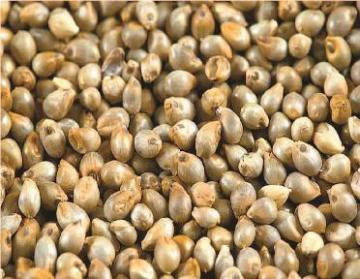
Pearl millet (Pennisetum typhoides)
Local names: Gujarati, Hindi, Urdu and Punjabi: Bajra, Rajasthani and Marathi: Bajri, Telugu: Sajjalu, Kannada: Sajje, Tamil: Kambu
Pearl millet is the most widely grown type of millet. Grown in Africa and the Indian subcontinent since prehistoric times, it is generally accepted that pearl millet originated in Africa and was subsequently introduced into India. Pearl millet is well adapted to production systems characterized by drought, low soil fertility, and high temperature. It performs well in soils with high salinity or low pH. Because of its tolerance to difficult growing conditions, it can be grown in areas where other cereal crops, such as maize or wheat, would not survive. Today pearl millet is grown on over 260,000 km² worldwide. It accounts for approximately 50% of the total world production of millets. India is the largest producer of pearl millet. It is locally known as bajra, and is primarily consumed in the states of Haryana, Rajasthan, Gujarat and Madhya Pradesh.
Nutritive value
It resembles in feeding value to that of sorghum. The crude protein ranges from 12-15% and TDN from 70-75%. It is also rich in tannins. It can be used in place of maize in livestock feeding.
